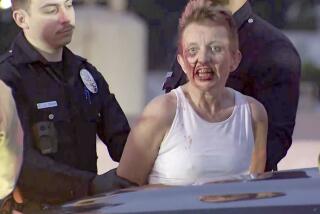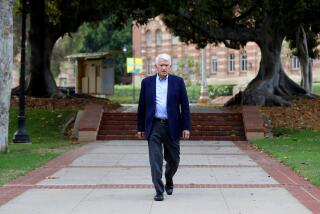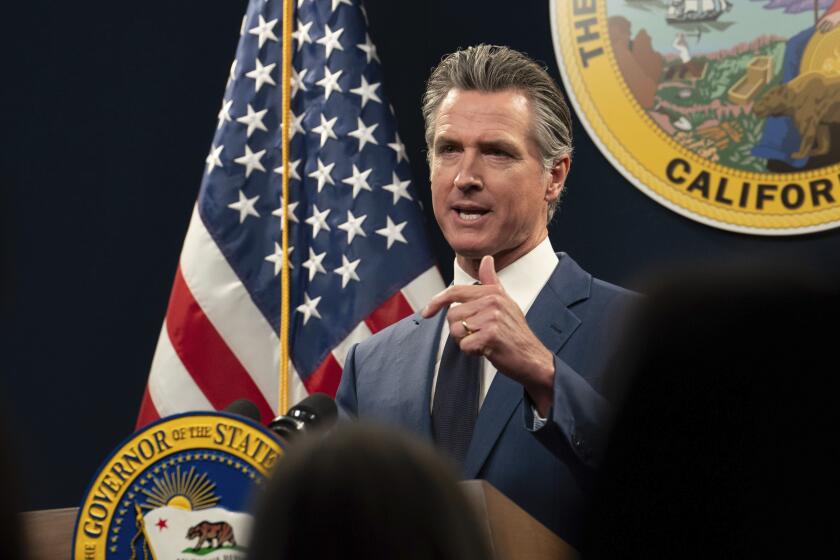UNITED IN HOPE : Linked by a common heritage and a war between their homelands, Iranian and Iraqi congregants at St. Paul Assyrian-Chaldean Catholic Church in North Hollywood join together to pray for peace.
Every Sunday morning, Manier Isho and Nino Issakhan pray in the same North Hollywood church.
After Mass, the two friends join their fellow parishioners in an adjacent hall for coffee and conversation. The adults eat bread and hard-boiled eggs as they trade gossip. The children play under the dining tables.
Although similar scenes are played out across the country every Sunday, the gathering at St. Paul Assyrian-Chaldean Catholic Church on Vanowen Street in North Hollywood is unique. The congregants pray together for peace, but their lives are linked to war.
Isho is from Iraq; Issakhan from Iran. About 80% of the 350 church members were born in one of these two countries.
“Never did I think,” said Isho, “that one day I would meet in the Valley, in California, an Assyrian from Iran. I have a great feeling every Sunday, seeing all the people from Iran and Iraq together. It’s a dream.”
The dream began in 1980, the same year the nightmarish war started between Iran and Iraq, a war that has killed hundreds of thousands. A precarious cease-fire has been in effect since the summer, but tensions remain high.
Church Purchased
Eight years ago, members of the San Fernando Valley’s Assyrian-Chaldean community purchased a church in Montrose. (The Assyrians and Chaldeans were related peoples who flourished in Mesopotamia and Babylonia, respectively, in the 7th Century BC. Their descendants eventually ended up in Iraq and Iran.) Two years ago, the community bought the North Hollywood facility, and the first Mass was held there last year.
St. Paul’s is one of only four Assyrian-Chaldean churches in California, 10 in the United States. Congregants come from as far away as Riverside, Thousand Oaks and Orange County. The Rev. Amanoail H. Ishow, the church’s pastor, estimates there are 15,000 Assyrian-Chaldeans in California.
Church members say St. Paul’s brings into focus the past--their former lives in Iran or Iraq--and the future--their hope that Assyrian-Chaldean culture will endure. For a community that has survived centuries of persecution and is wary of assimilation into Western society, these are powerful ties.
“For 1 hour, each Sunday,” said Isho, who left Iraq in 1981, “I am not in the Valley. I am back in my country.”
Assyrians from both countries unite behind their common past, which transcends their national boundaries.
History of Persecution
In the 7th Century BC, the Assyrians, who are credited with important inventions in law, agriculture and writing, were conquered by the Medes and then were ruled for centuries by a succession of empires: the Persians, Greeks, Parthians, Muslims, Mongols and Turks. Often the victims of persecution, the remaining Assyrians scattered across the Middle East. Ishow says many Assyrians converted to Christianity in the first century.
“They had lost something in life,” Ishow said, “and they, at least, wanted to hope for a good afterlife.”
In recent centuries, the Catholic minorities in Iran and Iraq have felt alienated from Muslims and many have tried to leave. According to Turan Tunan, who received her master’s degree in Assyriology from UC Berkeley, contact between Assyrians in Iran and Iraq was easier before Ayatollah Ruhollah Khomeini assumed power in 1979.
“We never knew what an Assyrian from Iran was thinking,” Isho said. “How did they live? I used to learn a little from books, but I have learned so much more from the experience here in the United States. They are human in all the ways we are. There’s no way to separate them from us.”
But it has not been easy to leave the homelands. Assyrians have either escaped or never returned from overseas visits, Tunan said.
That’s how Isho got out of Iraq. Three years after he applied, he finally received a passport to travel abroad. When he left in 1981, he never returned.
Of those who stayed behind, many served in the 8-year conflict. Though Muslims filled most of the positions in the military, Tunan said, many Assyrians from both countries died in the war.
They are not forgotten.
“Because of the war, I have feelings ripping inside of me,” Issakhan said. “Every night, we prayed for God to stop the war between the two countries. We prayed for them all the time at church. I would always feel sorry when I heard of the deaths. I knew there were a large number of Assyrians serving in the Iraqi forces.”
One of them was Isho’s nephew, Johnny Hanna. In 1984, he was 18 when he died in the fighting. Isho had never met him yet was devastated.
“I pray for him every day,” Isho said. “He didn’t even know who he was fighting.”
What made Isho’s mourning easier was the outpouring of support from members of his church. They made him feel part of an extended family.
“I will never be able to explain the feeling I felt when people from Iran came over to me to share my sadness,” he said, his eyes welling with tears. “Their country was fighting me and yet they came over to support me. I felt hope when that happened, the hope that the people back there will have the same feeling and war will end. I know now that whenever I need something, I can turn to anybody in the church, whether they’re from Iran or Iraq.”
Issakhan tells a story about bringing an Iraqi friend to a family picnic a few years ago. Somebody came up to him and asked if he realized what he had done.
“It wasn’t even something that I had thought about,” Issakhan said.
Ramona Sliva of Los Angeles immigrated to the United States from Iran in 1963 when she was 9.
“It’s not our war,” Sliva said. “It bothers me to say I’m from Iran. I was only born there. I am an American of Assyrian origin who happened to be born there. It has never affected me.”
Preserving Heritage
Nonetheless, it’s very important for Sliva to preserve her Assyrian-Chaldean heritage. For years, she attended U.S. Roman Catholic churches, listening to the prayers in English. But when she first started attending the North Hollywood church, she found it to be a more meaningful experience.
“Our Mass is still based on the ancient rituals,” Sliva said. “Our prayers are more elaborate, more touching. They fill my heart.”
The prayers are recited in ancient Aramaic and modern Sureth, the Assyrian language. It is that common language, church members say, that further unites them.
“It’s what ties us to our history,” Issakhan said. “Even though the dialects are different, and there are some words we can’t understand, we can communicate with each other, and that is so important.”
The churchgoers certainly embrace the religious and political freedom they found in the United States. Their religious rights were restricted in Iran and Iraq, they say. But when asked to go into details, they refuse, fearing government retribution against family members still in those countries. They prefer not to discuss any details of plans to rescue relatives from that region.
“No politics,” Ishow requested before his parishioners were interviewed. “If you are asked anything political, you know what to say.”
They nodded. They said nothing.
Still, they are concerned that the freedom in the United States may accomplish what all the centuries of persecution could not: the end of the Assyrian culture.
“We are what you could call an endangered species,” Issakhan said. “There are only between 1 and 2 million of us in the world.”
The Assyrians fear that as their children continue to be absorbed into modern American culture, they will lose their ties to history and not be able to speak the language of their ancestors. Sliva has already seen it happen.
“All my cousins are married to non-Assyrians,” Sliva said, “and they don’t speak a word of Assyrian. As far as I’m concerned, the culture in that part of the family is dead.”
Isho thinks this fear is another reason why several hundred Assyrian-Chaldeans attend Mass regularly. Many of them know each other from their native lands and use the post-service snack next door to make conversation. They speak quickly, hoping to maximize their moments together.
While old friendships are cemented, new ones are created. Some parishioners get together outside the church, to hold parties and dances. Issakhan helped found the Assyrian American Assn. of Southern California, which holds occasional meetings in North Hollywood.
“But it’s the church that’s the center. That’s why we need the church. Because without the church, we wouldn’t meet as often,” said Issakhan’s wife, Semiramis. “It’s when we are most happy.”
More to Read
Start your day right
Sign up for Essential California for news, features and recommendations from the L.A. Times and beyond in your inbox six days a week.
You may occasionally receive promotional content from the Los Angeles Times.






